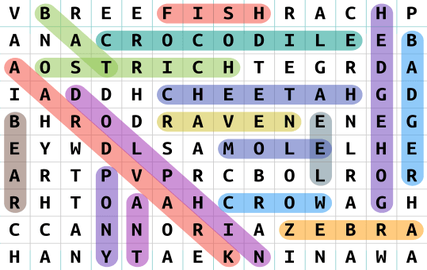The extra alphabet wrangling began after remembering a secret drawer in the pine coffee table my late partner
had built years ago.
That table isn’t in our living room anymore, but has been put to good use in the bedroom for houseplants. Here in
clay pots are yams with dozens of tangled tendrils; fragile lemon seed shoots which may or may not make it, and jade
and philodendron cuttings from California to remind me of where I came from.
Directly underneath the plants is that hidden drawer, and that’s where I unearthed a forgotten and fat word
search puzzle book with only a handful of completed pages.
The searches (also known as word find, word seek and wonder word) are set in square or rectangular grids, and most
are solved by circling words that read forward, backward, up and down, and diagonally, always in a straight line.
Each puzzle also has a “spotlight” theme, which varies by book. My book focuses on old movies and TV shows,
and is likely the reason I bought it.
So, there are puzzles for the TV shows Happy Days and Thirtysomething and Sesame Street, and movies including The French Connection, The Way We Were and How Green Was My Valley. A few singers are here, too, as well as directors and writers and bands.
I tackled only straight-line puzzles for years. But then I got bored, so upped the ante with zig-zag problems, where each word has one bend in it, and then patchwords, with every word reading clockwise or counterclockwise around the edges of a square or rectangular box. They’re more challenging but not so much that I give up.
And although I sold my first magazine piece in college, and think of myself as a word nut, I didn’t discover word search books until well until adulthood.
Right away, though, their pages took me to a simpler and calmer space.
Especially this year, the puzzles kept my worried and COVID fatigued brain at bay, giving my head a bit more room for hope and optimism. Also, it’s helpful for me to take out the book where and when I do: in our oversized puffy recliner and half an hour before bedtime.
Perhaps surprisingly, word searches weren’t invented until the mid-1960s.
It was then that prolific Spanish hobbyist and puzzle writer Pedro Ocon de Oro came up with a word puzzle called
Sopa de Letras, or Soup of Letters, which morphed into the word searches around today. But it was Norman Gibat,
from Norman, Oklahama, who has the distinction of printing the first English language word search.
There’s even an exact date: March 1, 1968.
That’s when Gibat’s small want-ad digest, distributed free to the local Safeway and other businesses, boasted a puzzle with the names of Oklahoma cities overlapping vertically, horizontally and diagonally.
Gibat featured new search puzzles in later issues, and that’s when educators saw their potential value for classrooms. Supposedly, one teacher sent Gibat’s puzzles to friends around the country and eventually, the idea of publishing a book made up of only word searches was born.
These days, I’m sure that most word search fans access puzzles on iPhones and computers, where they’re mostly free. But for me, spending a few bucks to feel the book in my hands, along with a sharpened pencil and a good eraser always within reach, just feels better.
Plus, once I’ve finished a puzzle, I draw a happy face at the top of the page.

 RSS Feed
RSS Feed
